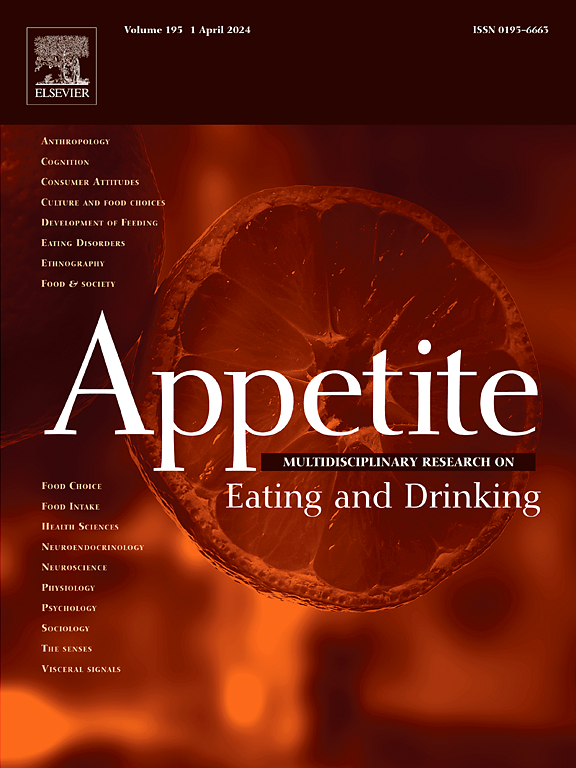The impact of the eco-score and the co-presence of Nutri-Score on sustainable food identification by consumers
IF 3.8
2区 医学
Q1 BEHAVIORAL SCIENCES
引用次数: 0
Abstract
Eco-labelling is a way to transparently communicate a product's environmental impact. A universal Eco-Score is under debate, and it remains unclear which form of eco-labelling best supports consumers in identifying sustainable food products, especially in combination with the Nutri-Score. The effectiveness of the Eco-Score on sustainability identification was assessed in two online choice tests (n = 1201, n = 938), by assessing: 1) Eco-Score vs. no label 2) the label design (letter vs. traffic light), 3a) the co-presence of Nutri-Score, and 3 b) similarity versus opposition between Nutri- and Eco-Scores. Results show that without Eco-Score, the overall mean correctness score was 52 % (the change rate of selecting the most sustainable food out of two). With Eco-Score, this improved to 72 % (p < 0.001). The single-letter version slightly outperformed the traffic light version (p = 0.018), particularly among lower-educated respondents. The co-presence of Nutri-Score reduced correct identification slightly (by 5 %), but only when the two scores showed opposite directions (p < 0.001). In conclusion, consumers benefit from a sustainability label to make informed food choices. The simpler letter format is at least as effective as the traffic light version. Although conflicting Nutri-Scores may slightly reduce sustainability identification, the overall positive effect of the Eco-Score remained strong. Adding a sustainability label like the Eco-Score alongside Nutri-Score offers complementary guidance on both health and environmental impact.
生态评分和营养评分共同存在对消费者可持续食品识别的影响。
生态标签是一种透明地传达产品环境影响的方式。一个普遍的生态评分正在辩论中,目前尚不清楚哪种形式的生态标签最能支持消费者识别可持续食品,特别是与营养评分相结合。通过两个在线选择测试(n = 1201, n = 938)评估Eco-Score对可持续性识别的有效性,通过评估:1)Eco-Score与无标签;2)标签设计(字母与交通灯);3a) Nutri- score的共同存在;3b) Nutri- score与Eco-Score之间的相似性与对立性。结果表明,在没有Eco-Score的情况下,总体平均正确性得分为52%(从两种食物中选择最可持续的食物的变化率)。使用Eco-Score,这一比例提高到72% (p < 0.001)。单字母版本略优于红绿灯版本(p = 0.018),特别是在受教育程度较低的受访者中。nutrition - score的同时存在略微降低了正确识别(5%),但仅在两个分数显示相反方向时(p < 0.001)。总之,消费者从可持续性标签中受益,从而做出明智的食品选择。简单的字母格式至少和交通灯格式一样有效。尽管相互冲突的营养评分可能会略微降低可持续性识别,但生态评分的总体积极影响仍然很强。在营养评分旁边加上生态评分这样的可持续性标签,可以对健康和环境影响提供补充指导。
本文章由计算机程序翻译,如有差异,请以英文原文为准。
求助全文
约1分钟内获得全文
求助全文
来源期刊

Appetite
医学-行为科学
CiteScore
9.10
自引率
11.10%
发文量
566
审稿时长
13.4 weeks
期刊介绍:
Appetite is an international research journal specializing in cultural, social, psychological, sensory and physiological influences on the selection and intake of foods and drinks. It covers normal and disordered eating and drinking and welcomes studies of both human and non-human animal behaviour toward food. Appetite publishes research reports, reviews and commentaries. Thematic special issues appear regularly. From time to time the journal carries abstracts from professional meetings. Submissions to Appetite are expected to be based primarily on observations directly related to the selection and intake of foods and drinks; papers that are primarily focused on topics such as nutrition or obesity will not be considered unless they specifically make a novel scientific contribution to the understanding of appetite in line with the journal's aims and scope.
 求助内容:
求助内容: 应助结果提醒方式:
应助结果提醒方式:


